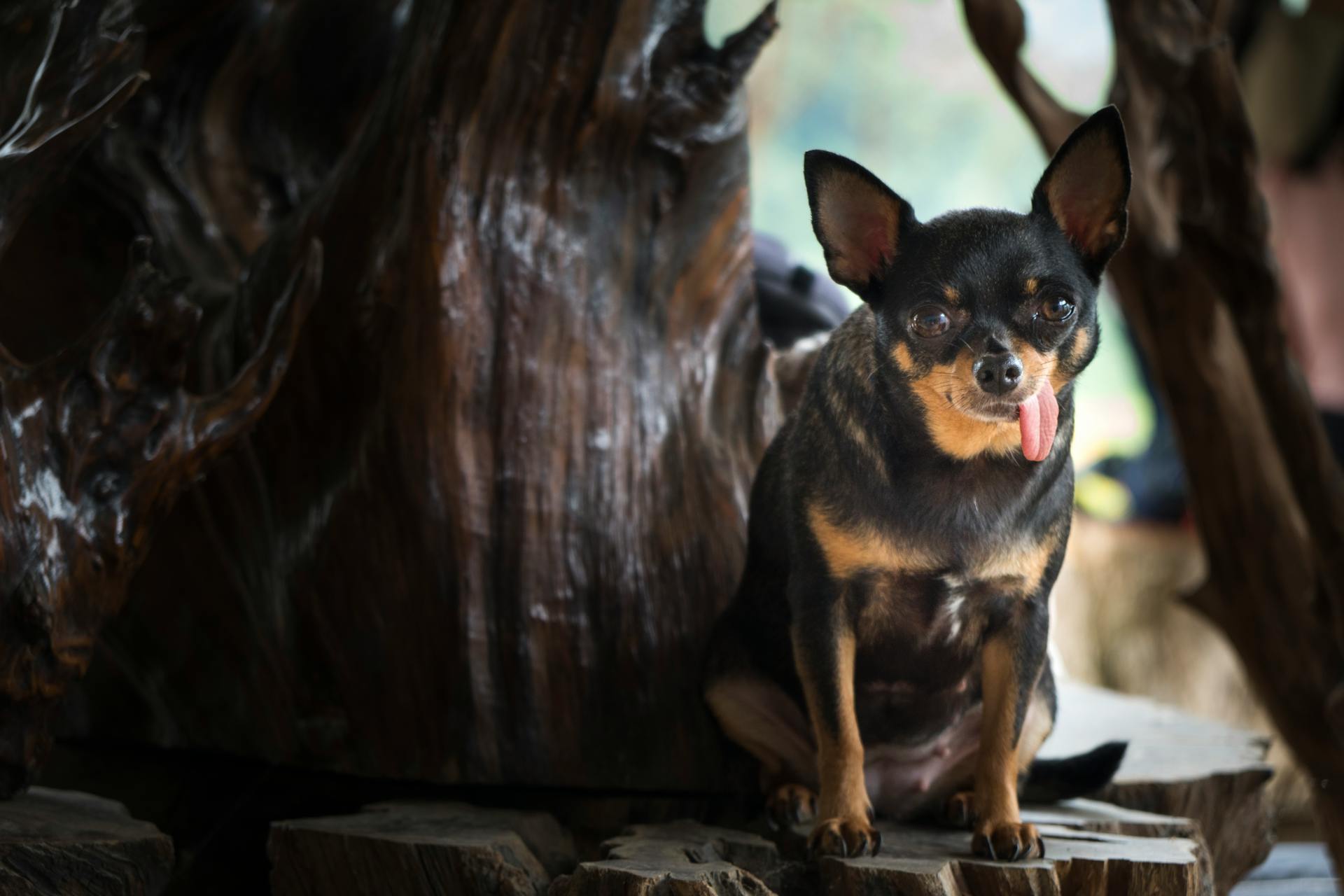
Chihuahuas are prone to hypothermia, which can be life-threatening, especially in temperatures below 50°F (10°C).
Their small body size and thin coat make them more susceptible to cold temperatures.
Prolonged exposure to cold can cause their body temperature to drop rapidly, leading to shivering, confusion, and even organ failure.
Chihuahuas can quickly lose heat through their thin fur, so it's essential to take precautions when taking them outside in cold weather.
Stay Safe This Winter
Dogs love spending time outside, but in the cold winter months, it's essential to keep them safe.
Dogs can get frostbite on their ears, paws, and nose if they're outside for too long when it's below freezing.
A fun frolic can become risky if your dog is exposed to cold temperatures for an extended period.
It's crucial to know the signs of hypothermia, which can include shivering, lethargy, and a low body temperature.
If you notice any of these signs, seek veterinary attention immediately.
Dogs can tolerate some cold, but it's best to keep them inside when the temperature drops below 40°F (4°C).
You can still take your dog for a walk, but make sure to dress them in a warm coat and booties to protect their paws.
Readers also liked: Diabetes in Dogs Symptoms
Factors to Consider
When you're considering the cold tolerance of your Chihuahua, it's essential to think about their age. Puppies, for example, have a harder time regulating their body temperature than adult dogs.
Chihuahuas with short coats are particularly vulnerable to cold temperatures, as they don't have a thick layer of fur to keep them warm.
Size
Smaller dogs, like Chihuahuas, have a harder time in the cold because they tend to lose body heat faster than larger dogs.
Deep snow can reach their chest and make them cold and wet, so they're more at risk in colder temperatures.
Small dogs have a larger surface area to volume ratio compared to big dogs, which means they have a bigger surface to lose heat through.
This makes them get colder faster than large dogs, all other things being equal.
For more insights, see: When Do Dogs Lose Puppy Energy
Weight
Body fat is a good insulator, which is why thinner dogs tend to get colder faster in low temperatures.

Thinner dogs generally get colder faster than heavier dogs.
Thicker dogs have a natural advantage in cold weather because their body fat acts as insulation.
However, it's essential to remember that making your dog overweight is not a solution.
Overweight dogs face greater health risks than any warmth benefit of a little extra fat.
In fact, making your dog overweight is considered animal cruelty.
You might like: Fat Corgi Dog
Age and Health
As dogs age, their ability to regulate their body temperature decreases. Puppies may have less body fat to act as insulation. Dogs that are sick or senior may not be able to increase their metabolic rate to generate extra heat. This can make them more susceptible to the cold.
Puppies' relatively small size also works against their ability to stay warm. Senior dogs and those with underlying health problems need extra protection from the cold. Be sure to keep their walks short and provide them with proper accessories, like dog sweaters or coats.
For more insights, see: Elderly Dog Boarding
Dampness

Dampness can quickly chill a dog even if the air temperature is mild, especially if it soaks through the fur.
Rain, snow, and heavy fog are all forms of dampness that can be hazardous for dogs.
Going for a swim can be a fun activity for dogs, but it's essential to dry them off thoroughly to prevent dampness from setting in.
Heavy fog can be particularly problematic for dogs, as it can seep into their fur and cause them to lose body heat quickly.
A unique perspective: Do Chihuahuas Have Hair or Fur
Temperature and Weather
Temperatures above 45°F should not be a problem for most Chihuahuas, but remember that size, age, and coat matter.
Chihuahuas can start to feel uncomfortable in temperatures below 45°F, especially if they're small, young, senior, or have short or thin coats.
In temperatures below 32°F, owners need to pay close attention to their pet's well-being, especially if they're small or have health conditions.
Temperatures below 20°F can be extremely hazardous for Chihuahuas, and owners should never leave them outside in these conditions.
For another approach, see: Are Chihuahuas Good for First Time Owners
Hypothermia
Hypothermia is a serious concern for Chihuahuas, especially in cold climates. Pale skin and gums are early signs that your Chihuahua may be experiencing hypothermia.
Shivering is another common symptom, as well as lethargy and whining. If you notice your Chihuahua stumbling or having trouble with coordination, it's a sign that they're getting too cold.
Dilated pupils and low heart and breathing rates are also indicators of hypothermia. Curled up in a ball is a clear sign that your Chihuahua is trying to conserve heat.
To prevent hypothermia, never leave your Chihuahua outside in freezing temperatures. Keep walks and potty breaks short, and bundle up if you anticipate being outside for longer.
Here are some common signs that your Chihuahua is cold:
- Trying to walk back to the house
- Jumping up and begging to be carried
- Whining
- Acting anxious
- Lifting their paws because the ground is uncomfortably cold
- Shaking or shivering
- Becoming less active
If you notice any of these signs, it's a good idea to cut your outdoor activity short and take your Chihuahua to a warmer place. If they're acting playful, sniffing their surroundings, and seeming happy, then they're probably enjoying themselves and not too cold.
Prevention and Preparation
Dogs with thin undercoats, like Chihuahuas, may benefit from sporting a jacket during winter jaunts. This is especially true if there's a chance your dog will get wet from snow or sleet.
Keep walks and potty breaks short to prevent hypothermia. Freezing outdoor temperatures can be hazardous for your dog.
If you'll be out in the cold with your Chihuahua for an extended time, consider foot protection like booties or musher's wax to guard your pup's paws against frostbite.
You might want to have a garment around your Chihuahua's core so they're not constantly losing heat. This is especially important for dogs with thin undercoats.
Emergency Response
Dogs in general are pretty resilient, but some situations can be scary. In many cases, getting your Chihuahua to a warm, dry place will be enough to restore their health.
Making sure they get something to eat can help, too. If your pet has hypothermia, they'll shiver and curl up for warmth, and their breathing and heart rates may change.
You don't want to dump them into a hot bath, as that can shock their system. Go somewhere where you can dry their fur and gradually warm them up.
Recommended read: Can Husky Dogs Live in Hot Weather
Frequently Asked Questions
What is the best room temperature for a Chihuahua?
For a comfortable Chihuahua, the ideal room temperature is between 50°F and 85°F (10°C to 29°C). If it's colder, consider providing a coat or sweater for extra warmth.
Sources
- https://outwardhound.com/furtropolis/dogs/how-cold-is-too-cold-for-dogs
- https://www.petmd.com/dog/care/how-cold-too-cold-dog
- https://www.dogtopia.com/blog/how-cold-is-too-cold-for-dogs/
- https://www.fetchpet.com/the-dig/how-cold-is-too-cold-for-your-dog
- https://www.5280.com/how-cold-is-too-cold-to-take-your-dog-outside/
Featured Images: pexels.com


